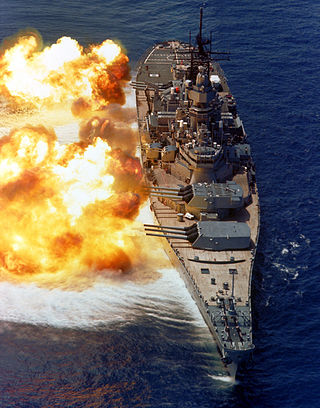
A battleship is a large, heavily armored warship with a main battery consisting of large-caliber guns, designed to serve as capital ships with the most intense firepower. Before the rise of supercarriers, battleships were among the largest and most formidable weapon systems ever built.

The battlecruiser was a type of capital ship of the first half of the 20th century. These were similar in displacement, armament and cost to battleships, but differed in form and balance of attributes. Battlecruisers typically had thinner armour and a somewhat lighter main gun battery than contemporary battleships, installed on a longer hull with much higher engine power in order to attain greater speeds. The first battlecruisers were designed in the United Kingdom, as a development of the armoured cruiser, at the same time as the dreadnought succeeded the pre-dreadnought battleship. The goal of the design was to outrun any ship with similar armament, and chase down any ship with lesser armament; they were intended to hunt down slower, older armoured cruisers and destroy them with heavy gunfire while avoiding combat with the more powerful but slower battleships. However, as more and more battlecruisers were built, they were increasingly used alongside the better-protected battleships.
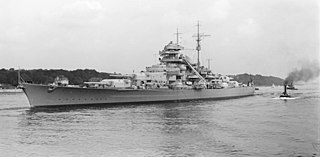
Bismarck was the first of two Bismarck-class battleships built for Nazi Germany's Kriegsmarine. Named after Chancellor Otto von Bismarck, the ship was laid down at the Blohm & Voss shipyard in Hamburg in July 1936 and launched in February 1939. Work was completed in August 1940, when she was commissioned into the German fleet. Bismarck and her sister ship Tirpitz were the largest battleships ever built by Germany, and two of the largest built by any European power.
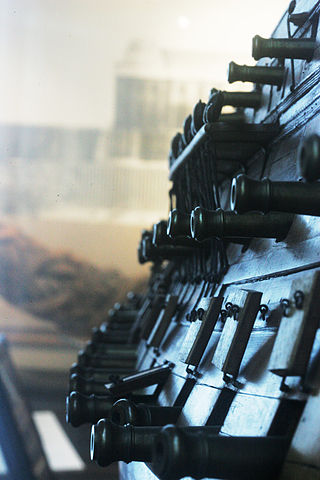
A broadside is the side of a ship, or more specifically the battery of cannon on one side of a warship or their coordinated fire in naval warfare, or a measurement of a warship's maximum simultaneous firepower which can be delivered upon a single target. From the 16th century until the early decades of the steamship, vessels had rows of guns set in each side of the hull. Firing all guns on one side of the ship became known as a "broadside". The cannon of 18th-century men of war were accurate only at short range, and their penetrating power mediocre, which meant that the thick hulls of wooden ships could only be pierced at short ranges. These wooden ships sailed closer and closer towards each other until cannon fire would be effective. Each tried to be the first to fire a broadside, often giving one party a decisive headstart in the battle when it crippled the other ship.
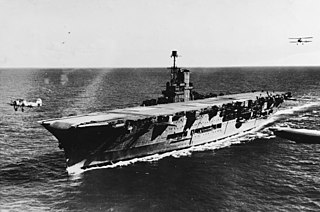
HMS Ark Royal was an aircraft carrier of the Royal Navy that was operated during the Second World War.

An ironclad was a steam-propelled warship protected by steel or iron armor constructed from 1859 to the early 1890s. The ironclad was developed as a result of the vulnerability of wooden warships to explosive or incendiary shells. The first ironclad battleship, Gloire, was launched by the French Navy in November 1859, narrowly preempting the British Royal Navy. However, Britain built the first completely iron-hulled warships.

The Iowa class was a class of six fast battleships ordered by the United States Navy in 1939 and 1940. They were initially intended to intercept fast capital ships such as the Japanese Kongō class and serve as the "fast wing" of the U.S. battle line. The Iowa class was designed to meet the Second London Naval Treaty's "escalator clause" limit of 45,000-long-ton (45,700 t) standard displacement. Beginning in August 1942, four vessels, Iowa, New Jersey, Missouri, and Wisconsin, were completed; two more, Illinois and Kentucky, were laid down but canceled in 1945 and 1958, respectively, before completion, and both hulls were scrapped in 1958–1959.

The Duncan class was a class of six pre-dreadnought battleships built for the Royal Navy in the early 1900s. The six ships—HMS Duncan, HMS Albemarle, HMS Cornwallis, HMS Exmouth, HMS Montagu, and HMS Russell—were ordered in response to Russian naval building, specifically the fast second-class battleships of the Peresvet class, which they were specifically to counter. The foremost design consideration was a high top speed to match the rumoured top speed of 19 knots of the Russian ships while maintaining the same battery of 12-inch (300 mm) guns and keeping displacement from growing. This forced significant compromises in armour protection, though the ships adopted a revised system of protection for the bow, which was copied in other designs like the London class.
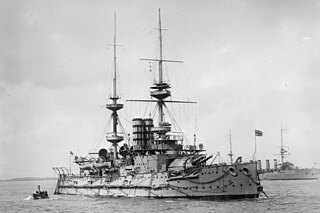
The Majestic class of nine pre-dreadnought battleships were built for the Royal Navy in the mid-1890s under the Spencer Programme, named after the First Lord of the Admiralty, John Poyntz Spencer. With nine units commissioned, they were the most numerous class of battleships. The nine ships, HMS Majestic, Caesar, Hannibal, Illustrious, Jupiter, Magnificent, Mars, Prince George, and Victorious, were built between 1894 and 1898 as part of a programme to strengthen the Royal Navy versus its two traditional rivals, France and Russia. This continued the naval re-armament initiatives begun by the Naval Defence Act 1889.

The Mackensen class was the last class of battlecruisers to be built by Germany in World War I. The design initially called for seven ships, but three of them were redesigned as the Ersatz Yorck class. Of the four ships of the Mackensen class, Mackensen, Graf Spee, and Prinz Eitel Friedrich were launched, and Fürst Bismarck was not—but none were completed, after wartime shipbuilding priorities were redirected towards U-boats—and the ships were broken up in the early 1920s. The lead ship of the class was named for August von Mackensen, a prominent military commander during the war. In response to the Mackensen-class ships, the British Royal Navy laid down the Admiral-class battlecruisers, all but one of which would eventually be cancelled; the sole survivor, HMS Hood, was completed after the end of the war.

The Deutschland class was a series of three Panzerschiffe, a form of heavily armed cruiser, built by the Reichsmarine officially in accordance with restrictions imposed by the Treaty of Versailles. The ships of the class, Deutschland, Admiral Scheer, and Admiral Graf Spee, were all stated to displace 10,000 long tons (10,160 t) in accordance with the Treaty, though they actually displaced 10,600 to 12,340 long tons at standard displacement. The design for the ships incorporated several radical innovations, including the first major use of welding in a warship and all-diesel propulsion. Due to their heavy armament of six 28 cm (11 in) guns and lighter weight, the British began referring to the vessels as "pocket battleships". The Deutschland-class ships were initially classified as Panzerschiffe, but the Kriegsmarine reclassified them as heavy cruisers in February 1940.

The König class was a group of four dreadnought battleships built for the German Kaiserliche Marine in the early 1910s. The class comprised König, the lead ship, Grosser Kurfürst, Markgraf, and Kronprinz. The design for the ships was derived from the preceding Kaiser class, using the same basic hull but with the main battery of ten 30.5 cm (12 in) guns in five twin-gun turrets rearranged to improve the guns' firing arcs. Instead of the staggered wing turrets used in the Kaisers, the Königs placed their main guns all on the centerline using superfiring pairs fore and aft. Budgetary constraints and the need to begin construction quickly to compete with Britain in the Anglo-German naval arms race prevented any more radical changes. Diesel engines were planned for the ships, but they could not be readied in time, so all four vessels reverted to steam turbines for their propulsion system.

A fast battleship was a battleship which in concept emphasised speed without undue compromise of either armor or armament. Most of the early World War I-era dreadnought battleships were typically built with low design speeds, so the term "fast battleship" is applied to a design which is considerably faster. The extra speed of a fast battleship was normally required to allow the vessel to carry out additional roles besides taking part in the line of battle, such as escorting aircraft carriers.

The Prince Consort class of ironclad battleship were four Royal Navy wooden-hulled broadside ironclads: HMS Royal Oak, HMS Prince Consort, HMS Ocean, and HMS Caledonia. They were originally laid down as Bulwark-class battleship, but were converted to ironclads. Royal Oak was Britain's fifth ironclad battleship completed.

The dreadnought was the predominant type of battleship in the early 20th century. The first of the kind, the Royal Navy's HMS Dreadnought, had such an effect when launched in 1906 that similar battleships built after her were referred to as "dreadnoughts", and earlier battleships became known as pre-dreadnoughts. Her design had two revolutionary features: an "all-big-gun" armament scheme, with an unprecedented number of heavy-calibre guns, and steam turbine propulsion. As dreadnoughts became a crucial symbol of national power, the arrival of these new warships renewed the naval arms race between the United Kingdom and Germany. Dreadnought races sprang up around the world, including in South America, lasting up to the beginning of World War I. Successive designs increased rapidly in size and made use of improvements in armament, armour, and propulsion throughout the dreadnought era. Within five years, new battleships outclassed Dreadnought herself. These more powerful vessels were known as "super-dreadnoughts". Most of the original dreadnoughts were scrapped after the end of World War I under the terms of the Washington Naval Treaty, but many of the newer super-dreadnoughts continued serving throughout World War II.

España was a Spanish dreadnought battleship, the lead ship of the España class, the two other ships being Alfonso XIII and Jaime I. The ship was built in the early 1910s in the context of a cooperative defensive agreement with Britain and France, as part of a naval construction program to restore the fleet after the losses of the Spanish–American War. She was the only member of the class to be completed before the start of World War I, which significantly delayed completion of the other vessels. The ships were armed with a main battery of eight 305 mm (12 in) guns and were intended to support the French Navy in the event of a major European war.

HMS Montagu was a Duncan-class pre-dreadnought battleship of the British Royal Navy. Built to counter a group of fast Russian battleships, Montagu and her sister ships were capable of steaming at 19 knots, making them the fastest battleships in the world. The Duncan-class battleships were armed with a main battery of four 12-inch (305 mm) guns and they were broadly similar to the London-class battleships, though of a slightly reduced displacement and thinner armour layout. As such, they reflected a development of the lighter second-class ships of the Canopus-class battleship. Montagu was built between her keel laying in November 1899 and her completion in July 1903. The ship had a brief career, serving for two years in the Mediterranean Fleet before transferring to the Channel Fleet in early 1905. During wireless telegraphy experiments in May 1906, she ran aground off Lundy Island. Repeated attempts to refloat the ship failed, and she proved to be a total loss. She was ultimately broken up in situ.















